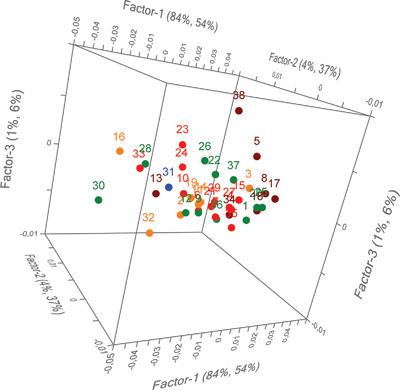当前位置:
X-MOL 学术
›
Macromol. Chem. Phys.
›
论文详情
Our official English website, www.x-mol.net, welcomes your
feedback! (Note: you will need to create a separate account there.)
Chemical Composition of Hexene‐Based Linear Low‐Density Polyethylene by Infrared Spectroscopy and Chemometrics
Macromolecular Chemistry and Physics ( IF 2.5 ) Pub Date : 2019-11-22 , DOI: 10.1002/macp.201900376 Olivier Boyron 1 , Manel Taam 1 , Christophe Boisson 1
Macromolecular Chemistry and Physics ( IF 2.5 ) Pub Date : 2019-11-22 , DOI: 10.1002/macp.201900376 Olivier Boyron 1 , Manel Taam 1 , Christophe Boisson 1
Affiliation

|
Mid and near infrared (MIR and NIR) spectroscopy associated with the partial least squares (PLS) method makes it possible to rapidly characterize the composition of linear low‐density polyethylene (LLDPE) in a large range of 1‐hexene content from 0 to 21 mol%. LLDPEs are produced using zirconocene catalysts activated with methylaluminoxane. PLS regression methods for MIR and NIR are constructed from this series of LLDPEs to quantify the 1‐hexene content in unknown copolymers. In this case, the PLS regression method aims to correlate the 1‐hexene content in the copolymers with their IR spectra. Multivariate calibration models are constructed by the PLS algorithm on pretreated data of MIR and NIR analyses. They are tested and validated by comparing results obtained by nuclear magnetic resonance and the PLS analyses for four unknown ethylene‐1‐hexene copolymers.
中文翻译:

己烯基线性低密度聚乙烯的红外光谱和化学计量学的化学组成
与偏最小二乘(PLS)方法相关的中红外和近红外(MIR和NIR)光谱学可以快速表征线性低密度聚乙烯(LLDPE)的1-己烯含量从0到21的大范围变化摩尔%。LLDPE是使用被甲基铝氧烷活化的锆茂催化剂生产的。从这一系列LLDPE中构建了MIR和NIR的PLS回归方法,以量化未知共聚物中的1-己烯含量。在这种情况下,PLS回归方法旨在将共聚物中的1-己烯含量与其红外光谱关联起来。通过PLS算法,根据MIR和NIR分析的预处理数据构建多元校准模型。
更新日期:2019-11-22
中文翻译:

己烯基线性低密度聚乙烯的红外光谱和化学计量学的化学组成
与偏最小二乘(PLS)方法相关的中红外和近红外(MIR和NIR)光谱学可以快速表征线性低密度聚乙烯(LLDPE)的1-己烯含量从0到21的大范围变化摩尔%。LLDPE是使用被甲基铝氧烷活化的锆茂催化剂生产的。从这一系列LLDPE中构建了MIR和NIR的PLS回归方法,以量化未知共聚物中的1-己烯含量。在这种情况下,PLS回归方法旨在将共聚物中的1-己烯含量与其红外光谱关联起来。通过PLS算法,根据MIR和NIR分析的预处理数据构建多元校准模型。











































 京公网安备 11010802027423号
京公网安备 11010802027423号